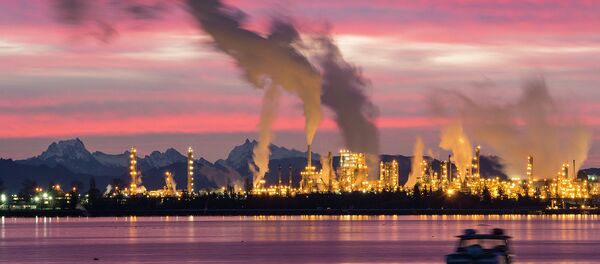MOSCOW (Sputnik) — Greenhouse gas emission targets set by last year's Paris Agreement on climate change are insufficient to meet the declared goal of keeping global temperature rises to below 2 degrees Celsius, the International Energy Agency (IEA) said in its latest annual World Energy Outlook report.
"Countries are generally on track to achieve, and even exceed in some instances, many of the targets set in their Paris Agreement pledges; this is sufficient to slow the projected rise in global energy-related CO2 emissions, but not nearly enough to limit warming to less than 2 °C," IEA said in the World Energy Outlook 2016 report.
"The overall energy sector carbon budget for even more ambitious "well below 2°C" or "1.5°C" pathways would likely require emissions to fall to zero sometime between 2040 and 2060, even with carbon removal technologies," the report said.
The Paris Agreement on climate change was adopted in December 2015 at the 21st UN Climate Change Conference (COP21). The deal aims to limit global average temperatures to less than 2 degrees Celsius above pre-industrial levels. The agreement also aims to create more financing to curb greenhouse gas emissions and support more climate-resilient development.
Global Oil Demand Growth to Slow Over Coming Years
Global oil demand growth is expected to slow down over the next five years.
"Over the medium term (the next five years), the rate of global oil demand growth is expected to slow. There are signs of a gear-change in the Chinese economy, which has been the engine of global growth over the past ten years," the IEA said.
While the Chinese government is shifting its focus on economic growth in sectors which consume less energy, other countries have carried out oil pricing reforms and slashed subsidies amid the ongoing price slump, thus contributing to slowing demand, according to the report.
In the longer-term scenario, the report forecast annual demand growth to average at 1 million barrels per day through to 2040 given current policies. Demand is expected to rise even slower given more energy efficient policies, while a major fall in demand would take place if the 2015 Paris Agreement on climate change is adhered to.
Weak demand for oil, alongside a glut in global oil markets, has been one of the reasons behind the ongoing price slump which caused oil prices to plunge from $115 per barrel in June 2014 to less than $30 per barrel in January 2016. Demand has somewhat picked up since then, driving prices back to around $50 per barrel.
Global Oil Demand to Grow by Nearly 12% Up to 103.5Mln Barrels Per Day by 2040
By 2040, world oil demand will grow by almost 12 percent, up to 103.5 million barrels per day, with OPEC providing a considerable share of nearly 50 percent of global production for the first time since 1970s.
At the same time, the transport and petrochemical sectors will account for 73 percent of oil demand by 2040, against 68 percent in 2015.
As for production, the figure in non-OPEC countries by 2020 will rise to 54.3 million barrels per day from 53.2 million barrels per day in 2015. The peak of production in the forecast period will be in 2025, when the figure will stand at 54.4 million barrels per day.
Subsequently, the rate will begin to decline and will reach 52.4 million barrels per day by 2040. The share of non-OPEC countries in world production by 2040 will be reduced to 52percent from 58 percent in 2015.
Prolonged Oil Investment Drop May Cause Price Turbulence
Prolonged global underinvestment in the oil sector may lead to a more volatile oil market in the future, according to the IEA.
The oil market, which is currently suffering from oversupply and a slump in prices, has been slowly recovering over recent months as demand rebounded and investment in the sector fell.
"There is also the risk of an over-correction… There is scope to recover from one or two years of suppressed project approvals, but with the level of demand growth seen in the New Policies Scenario, prolonging this into 2017 or beyond could lead to more volatile oil prices and a new boom-and-bust cycle for the industry," IEA said in its report.
The current rate of new oil field development approvals is showing no signs of a rebound after falling to the lowest level since the 1950s in 2015, according to the report.
Global Gas Demand to Rise by Almost 50% by 2040
The growth of global demand for gas is set to outpace all other fossil fuels, rising almost 50 percent by 2040, the International Energy Agency said.
"Global natural gas demand grows by nearly half over the Outlook period in the New Policies Scenario. The annual growth rate of 1.5% is lower than the 2.3% observed over the past 25 years, but gas is nonetheless the fastest growing among the fossil fuels and increases its share in global primary energy demand from 21% today to 24% in 2040," the IEA said.
Given a scenario whereby the 2015 Paris Conference target of keeping global warming below 2 degrees Celsius in achieved, demand growth for gas is expected to halt but not reverse before 2040, in contrast to falling oil demand under a similar scenario, according to the report.
The biggest demand gains by 2040 are forecast in China, the Middle East, India and Africa, while the United States and Europe are expected to see minor increases and Russian demand will hardly change.
In its previous outlook report, the IAE said that Asia was expected to catch up with the United States in terms of natural gas demand by 2025 before taking the global lead by 2030.
Gas prices fell by around 50 percent between early 2014 and 2016, driven by a glut in the energy market and the fall in commodity prices across the board.
Russia's Gas Production to Grow by Some 20% to Almost 760Bln Cubic Meters by 2040
Gas production in Russia is set to increase from 630 billion cubic meters in 2014 to 758 billion cubic meters in 2040, the International Energy Agency said in its report.
According to the report, the Russian gas production growth will be modest by 2020, when it is estimated to reach 636 billion cubic meters, before showing a fast-paced increase.
Oil Production in Russia to Drop From About 11Mln Barrels Per Day to 8.5Mln by 2040
Total oil production in Russia is expected to decrease from over 11 million barrels per day in 2015 to under 8.5 million barrels daily by 2040, the IEA said.
"But over the longer term, although new fields are developed in the mature conventional crude basins of West Siberia and the Volga-Urals, along with frontier projects, such as tight oil and in the Arctic, these are not sufficient to offset field declines and Russian production drops steadily, to under 8.5 mb/d by 2040," the World Energy Outlook 2016 report reads.
It is noted in the report that Russian oil producers had endured the drop in oil prices better than international companies, with many maintaining or even increasing capital spending in 2015.







